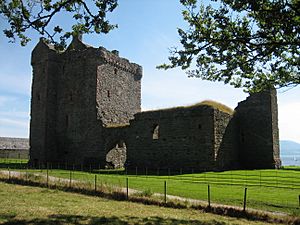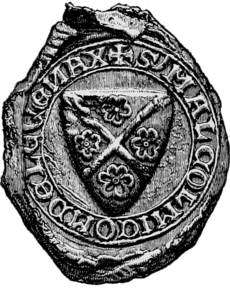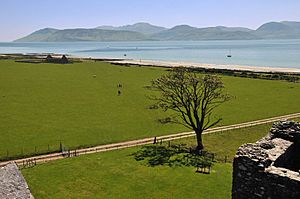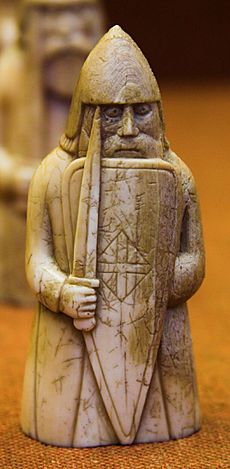Murchadh Mac Suibhne facts for kids
Quick facts for kids
Murchadh Mac Suibhne
|
|
|---|---|

Murchadh's name as it appears on folio 68v of Oxford Bodleian Library Rawlinson B 489 (the Annals of Ulster).
|
|
| Died | 1267 |
| Noble family | Clann Suibhne |
| Issue | Maol Mhuire an Sparáin |
| Father | Maol Mhuire mac Suibhne |
Murchadh Mac Suibhne (died 1267) was an important leader of Clann Suibhne, a powerful family in Scotland. He was the grandson of the family's founder, Suibhne mac Duinn Shléibhe. His uncle, Dubhghall mac Suibhne, was also a key figure in the family.
During Murchadh's time, the Scottish King wanted to control more land in Argyll and the Isles. As Scotland expanded, Clann Suibhne faced challenges from the Stewarts, one of Scotland's strongest families. Records from the 1260s show that Dubhghall gave up Clann Suibhne's lands to Walter Stewart, Earl of Menteith. It's not clear if this happened because of a battle.
Murchadh and some other members of Clann Suibhne did not want to be ruled by the Stewarts. So, Murchadh supported Hákon Hákonarson, King of Norway, who led a campaign in 1263 to take back Norwegian control. Murchadh played a big part in this. He led a group of islanders from Hákon's fleet into Loch Lomond. There, they attacked the the Lennox area. After the campaign, Murchadh was given the lordship of Arran as a reward.
Sadly for Murchadh, Scotland's power remained strong even after Hákon left. Scottish forces attacked the Isles the next year. Murchadh likely had no choice but to give in to the Scots. One of his sons was even kept as a hostage by the Scottish King.
Although Clann Suibhne lost its lands in Argyll by the 1260s, the family was closely connected to the Uí Domhnaill family in Ireland. Later, Clann Suibhne leaders commanded gallowglass warriors (a type of soldier) for the Uí Domhnaill and other Irish families. Murchadh himself may have been doing this when he died. He was captured in Connacht and died as a prisoner of Walter de Burgh, Earl of Ulster in 1267.
Scotland Expands: The Stewarts Arrive

During the rule of Alexander II, King of Scotland, Scotland began to expand its power into Argyll and the Isles. About ten years after Alexander II died, his son, Alexander III, became old enough to rule. He continued his father's plan to expand westward. The powerful Stewart family, led by Walter Stewart, Earl of Menteith, was at the front of this expansion. Old records from the early 1260s show that Clann Suibhne's lands were being given away.
For example, on April 17, 1261, Dubhghall, with his son Eóin's permission, gave the church of St Colmán Ela (Kilcalmonell) to Paisley Abbey. He also gave them the chapel of St Columba near Skipness Castle. Another document from Walter Stewart to Paisley Abbey, dated January 19, 1262, confirms Dubhghall's gift. It also says that Dubhghall had already given the lands of Skipness to Walter Stewart himself. Dubhghall was a witness to this deal, along with Murchadh and Murchadh's brother, Donn Sléibhe.

Other records show that Dubhghall gave his lands to Walter Stewart to be held as a "free barony." This meant he had to provide two-thirds of a knight's service to the king's army. More proof of the Stewarts taking over Clann Suibhne's main lands comes from Walter Stewart giving several churches in Knapdale to Kilwinning Abbey. These churches included St Abbán moccu Corbmaic (Keills Chapel), St Michael (Kilmichael of Inverlussa), and St Mary/St Máel Ruba (Kilmory Chapel).
It is not clear why Dubhghall made this agreement with Walter Stewart. There are no other records about how Clann Suibhne's lands were divided during this time. We also do not know if the Stewarts had already settled in Knapdale. The deals involving Clann Suibhne show that the family slowly lost its territories. It is unknown if these documents mean there was a military invasion. The Stewarts taking control of the region might have been part of Scotland's plan to expand its royal power into Argyll and the Isles. Both the Stewarts and the Scottish King likely saw Clann Suibhne as a threat to peace in the area. Getting rid of such families seemed to be a way to remove those who were not loyal. It also helped to form new partnerships with families who were more loyal to the Scottish Crown, like the Stewarts.
Norway's Big Campaign
While Alexander II focused on the south-west Highlands, Alexander III turned his attention to the Isles. In 1262, Scotland tried again to buy the Isles from Hákon Hákonarson, King of Norway, but failed. The old story Hákonar saga Hákonarsonar says that Hákon learned that Scotland wanted to take over the Isles. He also heard about recent Scottish attacks, including a harsh one on Skye. Because of this, Hákon gathered a huge fleet of ships. The Icelandic annals (old records) say it was the biggest fleet ever to sail from Norway. He wanted to show that Norway still ruled the north and west coasts of Scotland. Murchadh supporting the Norwegian side shows that some Clann Suibhne members did not want to be ruled by the Stewarts.
In July 1263, Hákon's fleet left Norway. By mid-August, Hákon had confirmed his rule in Shetland and Orkney. He also forced Caithness to submit and arrived in the Hebrides. The saga says that Magnús Óláfsson, King of Mann and the Isles and Dubhghall mac Ruaidhrí met Hákon there. As the fleet sailed south, Hákon sent a group of ships to attack Kintyre. This group was led by Dubhghall and Magnús Óláfsson. Hákon himself landed on Gigha.

Magnús and Dubhghall were clearly sent to get Aonghus Mór Mac Domhnaill and Murchadh to join the king's side. The saga describes the harsh attacks on Kintyre. It suggests that these attacks finally made Aonghus Mór and Murchadh agree to join Hákon. The saga shows that these powerful west-coast leaders submitted to Hákon. They swore loyalty, gave hostages, and handed over the island of Islay to him. The king also demanded a tax of one thousand cattle from the Kintyre headland. A certain fortress, likely Dunaverty Castle, was given to Hákon by an unknown knight.
In early September, the larger fleet of Norwegians and islanders entered the Firth of Clyde. The Hákonar saga Hákonarsonar says that Norwegian and Scottish messengers tried to make peace. But the Scottish King did not want to give up his claim to the islands of the Clyde: Bute, Arran, and the Cumbraes. After peace talks failed, the saga names Magnús Óláfsson, Dubhghall, Ailéan, Aonghus Mór, and Murchadh as leaders. They commanded a group of islanders and Norwegians who entered Loch Long. They then carried their ships across land into Loch Lomond and attacked the nearby region of the Lennox. This group had forty or sixty ships, a large part of Hákon's fleet. It seems this attack was aimed at the Stewarts' lands. The disputed islands of the Clyde almost certainly belonged to the Stewarts. Also, by going into the Earldom of Lennox and possibly further east, Hákon's supporters would have been entering the Earldom of Menteith. The saga praises Ailéan's military actions, saying he took hundreds of cattle and caused much damage in Scotland. Scottish records also support this inland campaign. John Lamberton, the Sheriff of Stirling, spent money to keep "vigilant men" at Stirling Castle when the Norwegian forces were in the area.

Meanwhile, in early October, Hákon's main force fought the Scots at Largs. Then, they went back to the Hebrides. Once Hákon's main force reunited with the group of islanders and Norwegians, the saga says Hákon rewarded his supporters from overseas. Dubhghall and Ailéan received the islands that had been taken from Eóghan Mac Dubhghaill. A person named Ruðri received Bute, and Murchadh was given Arran.
Even though the saga says the Norwegian campaign was a huge victory, it actually failed. Hákon did not break Scotland's power. Instead, Alexander III took action the next year. He led a series of invasions into the Isles and northern Scotland. Seeing this big change in power, Magnús Óláfsson submitted to Alexander III within a year. This showed that Norway's rule in the Isles had completely collapsed. Almost three years after Hákon's failed campaign, Scotland and Norway finally agreed to peace terms. With the Treaty of Perth in 1266, Hákon's son, Magnús Hákonarson, King of Norway, officially gave up all rights to Mann and the islands on Scotland's western coast. The dispute over Scotland's western islands was finally settled.

Because Norway lost its power, families like Clann Suibhne were more likely to face attacks from the Scottish King. The Scots' attacks against the islanders were led by Alexander Comyn, Earl of Buchan, Uilleam, Earl of Mar, and Alan Hostarius. Old writings from the 1300s and 1400s say these leaders oversaw the Scots' attacks on the islands. Other records also confirm this. They show that Scottish forces invaded the Isles the summer after Hákon's campaign. They forced Aonghus Mór and others who supported Norway to submit. Records from the Scottish treasury also show Uilleam received money for commanding two hundred soldiers for the king in the Hebrides. Further proof of a planned campaign against Hákon's supporters is that Walter Stewart gathered a royal fleet at Ayr. Uilleam also took twenty cattle from Kintyre.
After Norway left and Scotland strongly expanded its power into the Isles, Aonghus Mór and Murchadh had no choice but to submit to the Scots. They were forced to hand over their sons to ensure their good behavior. Murchadh's son was placed under the care of Robert Mowat, the Sheriff of Forfar. It seems that Clann Suibhne's power in Knapdale and Kintyre ended in the 1260s. The Stewarts took their place. This change of power clearly meant Scotland had more control in Argyll. It might also explain why Eóghan Mac Dubhghaill surprisingly refused to help Hákon against the Scottish King.
Moving to Ireland
Over time, Clann Suibhne became one of the most important military families in Ireland. Even though the clan might have sent gallowglass warriors to Ireland before losing their lands, Clann Suibhne seemed to become more involved in Irish matters after they were displaced. In fact, it might have been around the time they lost their lands in Scotland that they moved to Ireland. The first mention of the clan in the Irish annals (old records) is about Murchadh's death in 1267. He died as a prisoner of Walter de Burgh, Earl of Ulster.
Murchadh's death is mentioned in several old records, such as the Annals of Connacht, the Annals of the Four Masters, the Annals of Loch Cé, and the Annals of Ulster. These records say he was captured in the Owles, an area near Clew Bay. They also state that the local lord, Domhnall Iorrius mac Maghnusa Ó Conchobhair, handed him over to the earl. This local lord was known to be close to the English in Ireland. These old records might suggest that Walter de Burgh did not want Clann Suibhne to settle in Ireland. He might have helped speed up the family's removal from Argyll, whether he meant to or not.
An old Gaelic poem by Giolla Brighde Mac Con Midhe seems to show that Clann Suibhne was closely allied with the Uí Domhnaill family. Specifically, the Uí Domhnaill chief Domhnall Óg Ó Domhnaill, King of Tír Chonaill is said to have been raised by Clann Suibhne. Another old record, the Annals of the Four Masters, also suggests Domhnall Óg grew up overseas. It says he took over from his brother in 1258 after returning to Ireland from Scotland, speaking a Scottish dialect of Gaelic. So, it was partly the military strength of Domhnall Óg's foster-father that helped Domhnall Óg become chief at age seventeen.
It is possible that Domhnall Óg offered a safe place for the displaced Clann Suibhne. Murchadh's capture could be linked to unrecorded pirate activities or gallowglass operations. There is reason to think that the alliance between Clann Suibhne and the Uí Domhnaill was a reason why the Scottish King allowed Clann Suibhne to lose their lands in the 1260s. Such an alliance could have been a threat to Alexander III's plans to expand Scottish royal power westward. In fact, the king's worries seem to be shown by Scottish messengers asking Henry III, King of England to stop supporting Magnús Óláfsson. Like Clann Suibhne, Magnús became a target of Scottish attacks in the 1260s. He also seemed to have made a deal with a powerful Irish family earlier to strengthen his position.
See also
- Eóin Mac Suibhne, a later descendant of Murchadh who tried to take back Clann Suibhne's old lands in Argyll




